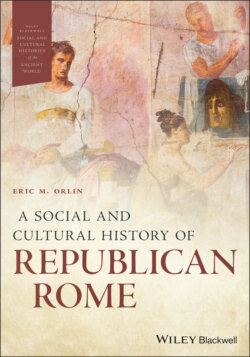Читать книгу A Social and Cultural History of Republican Rome - Группа авторов - Страница 35
Further Reading
Оглавление1 Cornell, Tim(1995). The Beginnings of Rome: Italy and Rome from the Bronze Age to the Punic Wars (c.1000–264 BC). London: Routledge.Although this book only provides discussion of the Roman Republic up to the beginning of the Punic Wars, it offers a tremendous synthesis of archaeological and literary material to provide a fundamental rethinking of the Early Republic. The relative lack of sources makes this period one of the most challenging to understand, and Cornell’s book provides useful clarity, even if some hypotheses must remain conjectural.
2 Flower, Harriet I.(2010). Roman Republics. Princeton, NJ: Princeton University Press.Flower offers a new analysis of the different periods of Roman Republican history. Rather than dividing the Republic into only three phases, she argues instead for a series of six distinct Republican forms of government, along with several transitional periods too brief to be considered a stable system of government. Her approach has the virtue of helping us recognize the tremendous degree of change that must have occurred over a nearly 500 year period.
3 Rosenstein, Nathan(2012). Rome and the Mediterranean 290 to 146 BC: The Imperial Republic. Edinburgh: Edinburgh University Press.Part of a series, Rosenstein focuses on the Middle Republic, the period when Rome acquired its territorial empire. He offers analysis of key historical problems, contained within an engaging overall text. His treatment of the Punic Wars is particularly detailed and offers insight into the reasons why the Romans went to war and how they acquired an empire.
4 Steel, Catherine E. W.(2013). The End of the Roman Republic, 146 to 44 BC: Conquest and Crisis. Edinburgh: Edinburgh University Press.Part of the same series as Rosenstein, Steel focuses on the Late Republic. She focuses especially on key issues such as freedom and honor, and power, greed and ambition, and explores the processes that transformed Rome from a republic to a monarchy. She depicts Rome as a dynamic and evolving system reflecting continuous changes in citizenship and in the elite classes.
5 Woolf, Greg(2012). Rome: An Empire’s Story. Oxford: Oxford University Press.Woolf offers a concise history of both the Roman Republic and the Roman Empire that followed the accession of Augustus. His focus is to consider Rome as an empire in theoretical terms and he often compares Rome to other world empires (China, for example), which helps show both the ways in which Rome behaved like other empires and ways in which it was unique.
